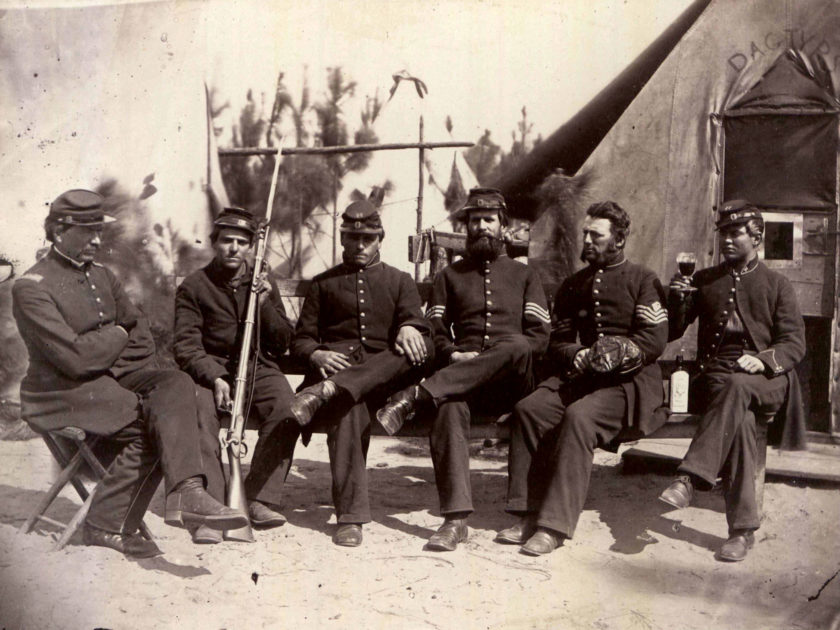By Ron Field
Period photography showing the variety of uniforms and headgear worn by New Hampshire soldiers during the first year or so of the Civil War is of great interest to collectors. Much of the clothing first provided for the volunteers from out-of-state suppliers proved unsuitable for the heat and rigor of campaigning in the South. Little improvement occurred when the state turned to local clothiers, tailors and hatters, with cloth for frock coats too thin and Havelock caps uncomfortable. The photographic legacy provides a rich archive of rare and unusual hats, caps and uniforms unique to the men of the Granite State.
Spike-tailed coats
The coat, pants and overcoats of “grey military cloth” for both the 1st and 2nd New Hampshire infantries were made in Boston by Whiting, Galloupe, Bliss & Co., and Whitten, Hopkins & Co. These regiments received their uniform clothing beginning in early May 1861, although by mid-month some elements of the 1st still not having received theirs, which resulted in about 400 men refusing to drill.
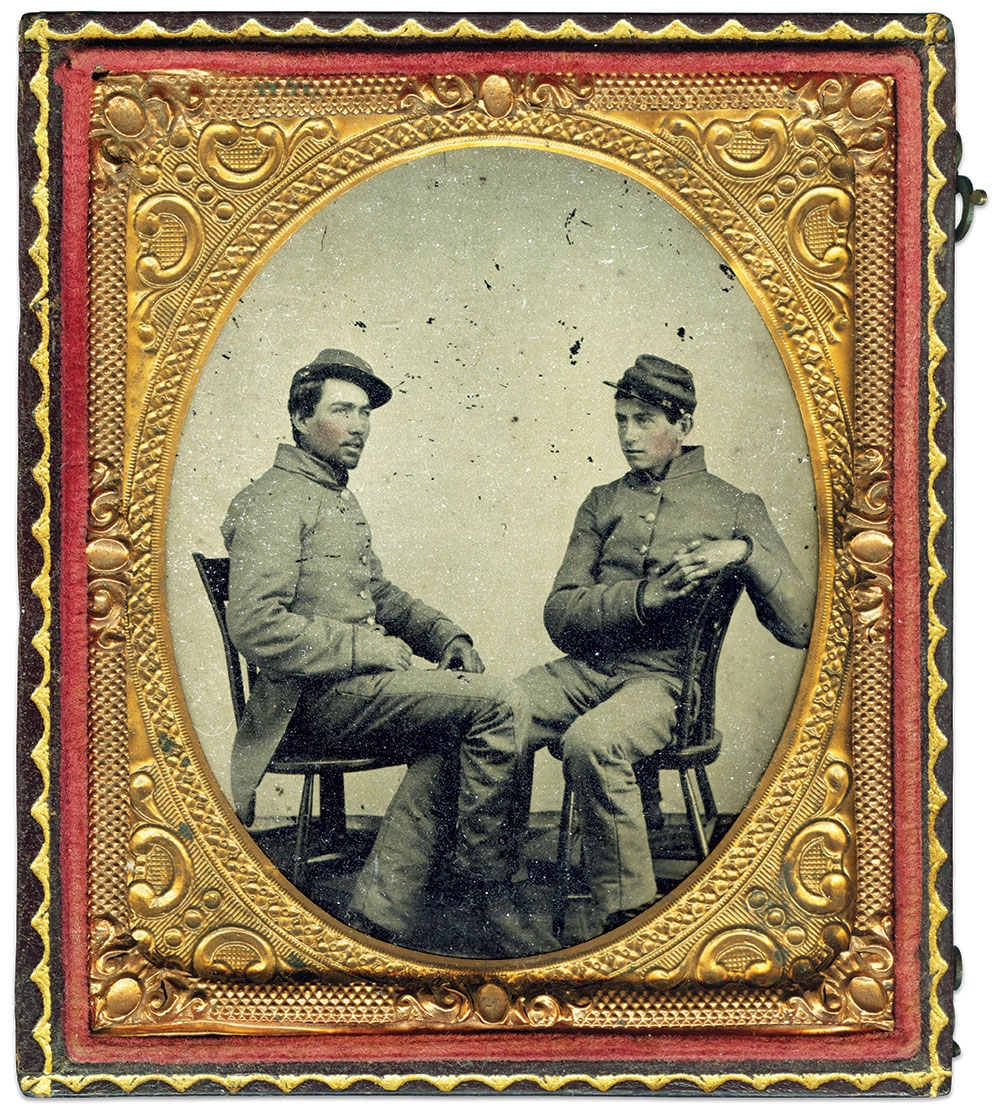
On May 10, 1861, Martin A. Haynes, a private in Company I of the 2nd, wrote, “The regiment is now uniformed in the queerest-looking uniform in the world. You have probable [sic] seen some like them in the streets of Manchester, on the First Regiment boys. The suit is gray throughout, with light trimming of red cord. The coat is a ‘swallow-tail,’ with brass buttons bearing the New Hampshire coat-of-arms; a French army cap to top off with.” In his history of the regiment, Haynes further described this uniform as “gray, the jaunty forage caps and “spiketail” dress coats banded with red cord.”
The rest of the uniform worn by the 1st and 2nd was made in state, as well as in Boston. George A. Barnes, a merchant based at Manchester, N.H., who acquired them from S. Klouse & Co., of Boston, supplied 1,000 gray chasseur-pattern caps with red bands. Although photographic evidence suggests that buttons bearing the state coat of arms were worn on cap fronts, an intoxicated man accused of being “a scallawag in the regiment” was stripped of his uniform, including “the letters on his cap,” on June 14, 1861.
An interesting array of rags
The thick grey uniforms of the 1st and 2nd New Hampshire regiments soon proved too hot for the South and, by late May, both regiments were also issued with 1857 Pattern four-button, blue flannel sack coats. By the end of its 3-month service, the appearance of the 1st New Hampshire was described in the New Hampshire Statesman on return home as “miserable in the extreme.” Many men were “destitute of shoes,” and others had “their pants worn away up as far as the knee, leaving the leg exposed.”
Writing from Camp Sullivan in Washington, D.C. on July 7, 1861, John W. Odlin, a musician in Company B of the 2nd, stated, “The clothes furnished us were miserable, and we present a very interesting array of rags when on dress parade. Looks however will amount to nothing after we pass into Virginia, and so long as the garments hold together we shall be comfortable.” The deterioration of its gray dress uniforms by the beginning of July 1861 likely indicates that this regiment wore its blue flannel fatigue blouses at First Bull Run. When it was re-organized for the war, it was uniformed in the dress of the regular army.
Crazy hats and rebel gray
Organized at Concord, N.H., and mustered-in for three years on Aug. 23, 1861, the 3rd New Hampshire Infantry was uniformed in “New Hampshire cloth,” considered to be of “a better shade [of grey] than that of the other regiments.” The frock coats and pants were of gray doeskin made by the Harris Mill at Harrisville, Cheshire County, and supplied by Lincoln & Shaw, of Concord, at a total cost of $9,505. Listed as “dealers in clothing” on the “Exchange Block” in the Concord City Directory of 1860-61, the firm owned by John G. Lincoln and Wentworth G. Shaw went on to also help clothe the 4th, 5th and 6th New Hampshire regiments.

Abram, or Abraham, Thorpe of Weare, N.H., made overcoats for the 3rd for $7,021. Blue flannel fatigue blouses were procured from Samuel A. & Benjamin F. Haley’s Tailoring Establishment at New Market, for $3,208. (See “The Citizenry,” MI, Autumn 2019 for a view of the Haley brothers’ premises and work force) This firm also probably supplied the fatigue blouses for the first two regiments.
Headgear issued to the 3rd was known as the Havelock cap. Designed by Charles F. Brooks of the State Military Committee of the Governor’s Council, it was possibly based on the “Whipple hat” patented by New York hatter Jonathan F. Whipple on July 16, 1861, and produced by the Seamless Clothing Manufacturing Company. Purinton & Ham, of Dover produced the New Hampshire version. Regimental musician Henry S. Hamilton described it in his Reminiscences of a Veteran as “a sort of dark pepper and salt shade, with a fore-and-aft peak. The latter as they aged persisted in lopping, sometimes in front, and then again behind, and not infrequently both front and behind, so that really they were not things of beauty by any means.”
Having taken part in the Port Royal expedition under Gen. Thomas W. Sherman during November 1861, the clothing of many soldiers in the 3rd had become threadbare. According to the regimental historian Daniel Eldredge, the “hard service … after landing at Hilton Head soon put those grey uniforms into a condition where we’d got to have new uniforms.”
First in Blue
Both the 4th and 5th New Hampshire infantries were the first Granite State regiments clothed in blue. Organized at Manchester during August and September 1861, the 4th received dark blue dress coats and sky-blue pants produced by Lincoln & Shaw made from cloth produced at the mill of B.F. & D. Holden, in West Parish, Concord. Blue blouses, or sack coats, issued to this regiment were made at Haley’s Tailoring Establishment. Once again, Purinton & Ham supplied the Havelock caps. Overcoats were made by Adams B. Cook, of Weare; grey flannel shirts and drawers, by Joseph W. Thorpe, of Hillsborough; poncho blankets by Warde, Humphrey & Co., of Concord; socks by John Pepper of Holderness, and shoes at a workshop in the State Prison in Concord.

According to the New Hampshire Statesman of Concord on Aug. 31, 1861, the 5th was originally to be “a Light Infantry Regiment, armed, uniformed and equipped precisely like the Regular Army.” Despite a poor experience with Boston-made uniforms for the first two regiments, the state authorities contracted with a firm in Portland, Maine, to make the uniforms for its 5th regiment. These uniforms were found “an inferior quality and shabby make.” As a result, uniforms of not much better quality made by Lincoln & Shaw and intended for the 6th regiment, went to the 5th New Hampshire.
Enlisting as a first sergeant in the 5th on Oct. 12, 1861, Thomas L. Livermore recalled in Days and Events, 1860-1866, published in 1920, “Our company was given the letter ‘K,’ and a uniform consisting of brogans, light-blue trousers and overcoat with cape, and dark-blue blouse and frock coat…” He described the Havelock hat as “a helmet-like structure of …waterproof cloth, with visor before and behind, the top resembling a squash, and the whole lined and padded, I think. This was the New Hampshire cap, and although it would do in a row to keep blows from the head and was good to protect the neck from rain, yet in summer it was a sweltering concern.”
The frock coats received by the 4th and 5th, plus the 6th and 8th regiments, were made of “shoddy” flannel. Unlike the pattern 1854 frock coat worn by the Regular U.S. army, they lacked trim around collar and cuffs, but had sky-blue edging all around shoulder straps as an additional feature.
More “shoddy”
The 6th New Hampshire Infantry organized at Keene, N.H., and mustered in on Nov. 27, 1861. Despite forfeiting the dark blue frock coats and sky-blue pants intended for it, this regiment quickly received replacement clothing of the same color and pattern from the industrious Lincoln & Shaw. Consisting of an orthodox fatigue cap with stiffened leather visor curved around sides and rear, the Havelock-style headgear supplied on this occasion by Purinton & Ham resulted from complaints about their first version. A report published later in the Daily Mirror, of Manchester, N.H., on Feb. 21, 1862 stated, “the Government has properly decided to do away with that abomination–the wide awake hat with tucked up brim–and to substitute it with a neat cap with extended horizontal visor.”
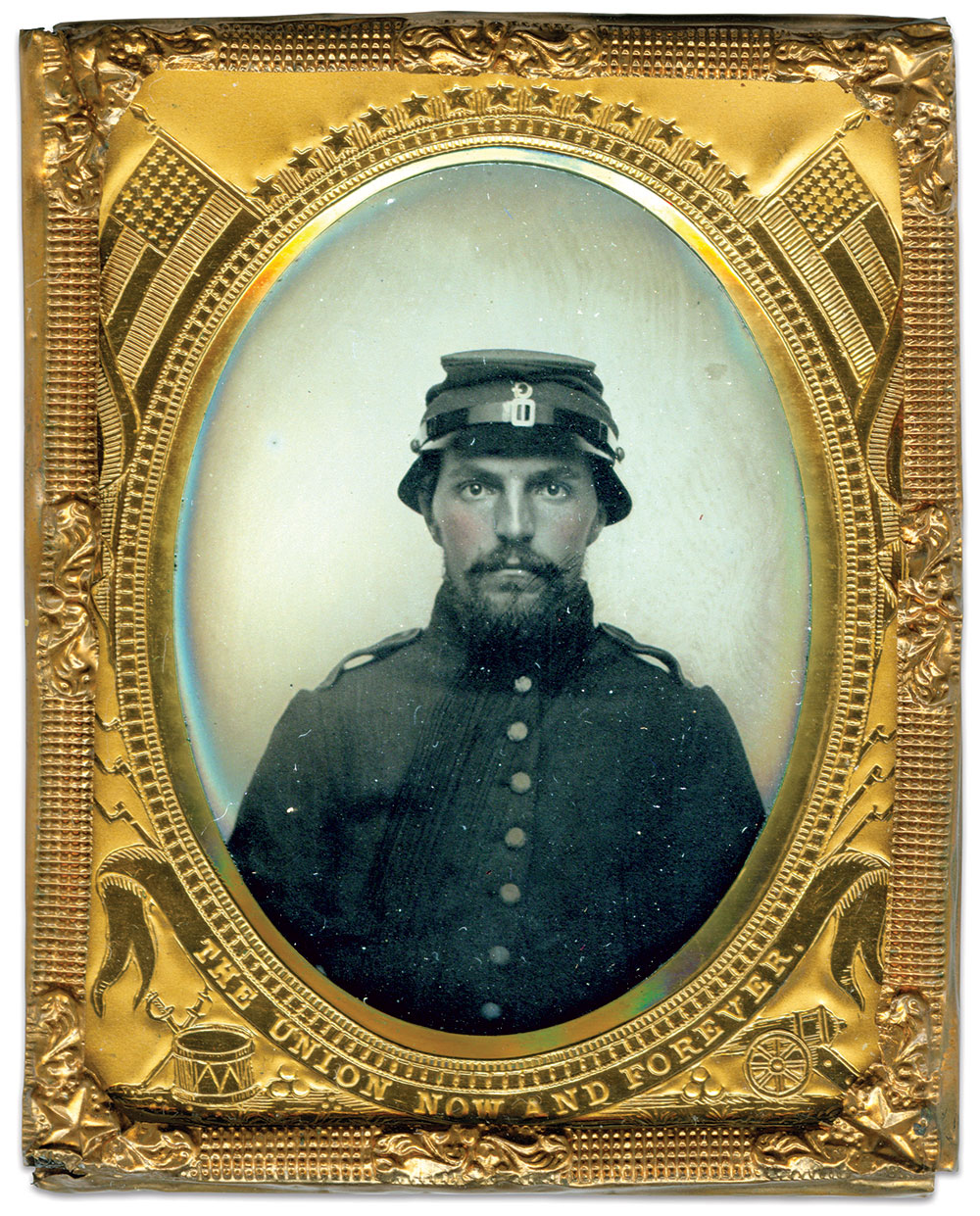
Benjamin Haley made blue flannel blouses. Overcoats were produced by Adams Cook, of Weare; shoes from the prison workshops in Concord; and “gun equipments and harness” by Solon S. Wilkinson, of Keene, N.H. On Dec. 12, 1861, a letter published in the New Hampshire Sentinel reported that all was not well with some of this clothing, stating, “The uniforms give good satisfaction, except the dress coats and blouses, which are rather thin and poorly made.” Once again, “shoddy” uniforms were issued to New Hampshire volunteers.
A regular regiment
Although raised within New Hampshire and credited to that state, the 7th New Hampshire Infantry was organized upon the request of Adjutant General Joseph C. Abbott by direction of the War Department at Washington, under the date of Sept. 2, 1861. Having served as state adjutant-general from 1855 through 1861, Abbott wished to defend the Union cause in the field, and was commissioned a lieutenant colonel of the 7th regiment, with West Point graduate and regular army officer Haldimand S. Putnam as colonel.
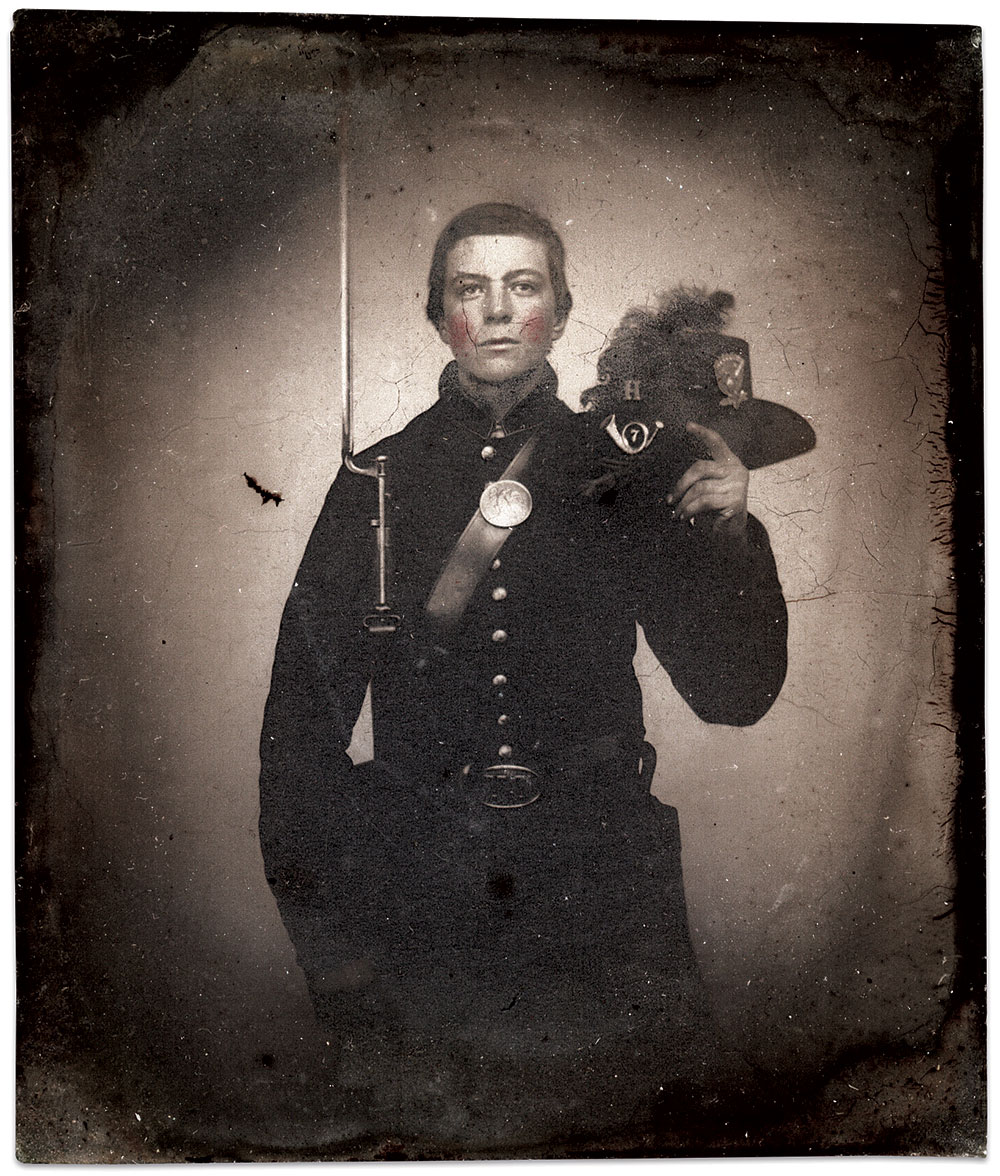
Organized at Manchester and mustered in Dec. 13, 1861, the 7th subsequently received its clothing, arms and equipment from the federal government. According to a report in the New Hampshire Statesman, the uniforms were “precisely like those of the regular army,” and were sent direct from Washington, D.C. Regimental historian Henry Little described them as consisting of “‘keg hats’ of black felt, trimmed with feathers and brasses, dark blue dress coats, dark blue trousers, light blue overcoats, dark blue blouses, and dark blue fatigue caps, the trimmings and chevrons of light blue, except the dark blue on the overcoats.”
“Not so good but will hold vermin”
Some of the clothing received by the 8th New Hampshire Infantry, organized at Manchester and mustered in Dec. 23, 1861, was also of inferior quality. Made by Haley’s Tailoring Establishment at New Market, N.H., the blue flannel frock coats and blouses received on Jan. 16, 1862, were described by an unknown volunteer as being “not so good but will hold vermin.” The same man added that the pants made by the same firm, and the modified Havelock caps with extended visor produced by Purinton & Ham, were “very good.”
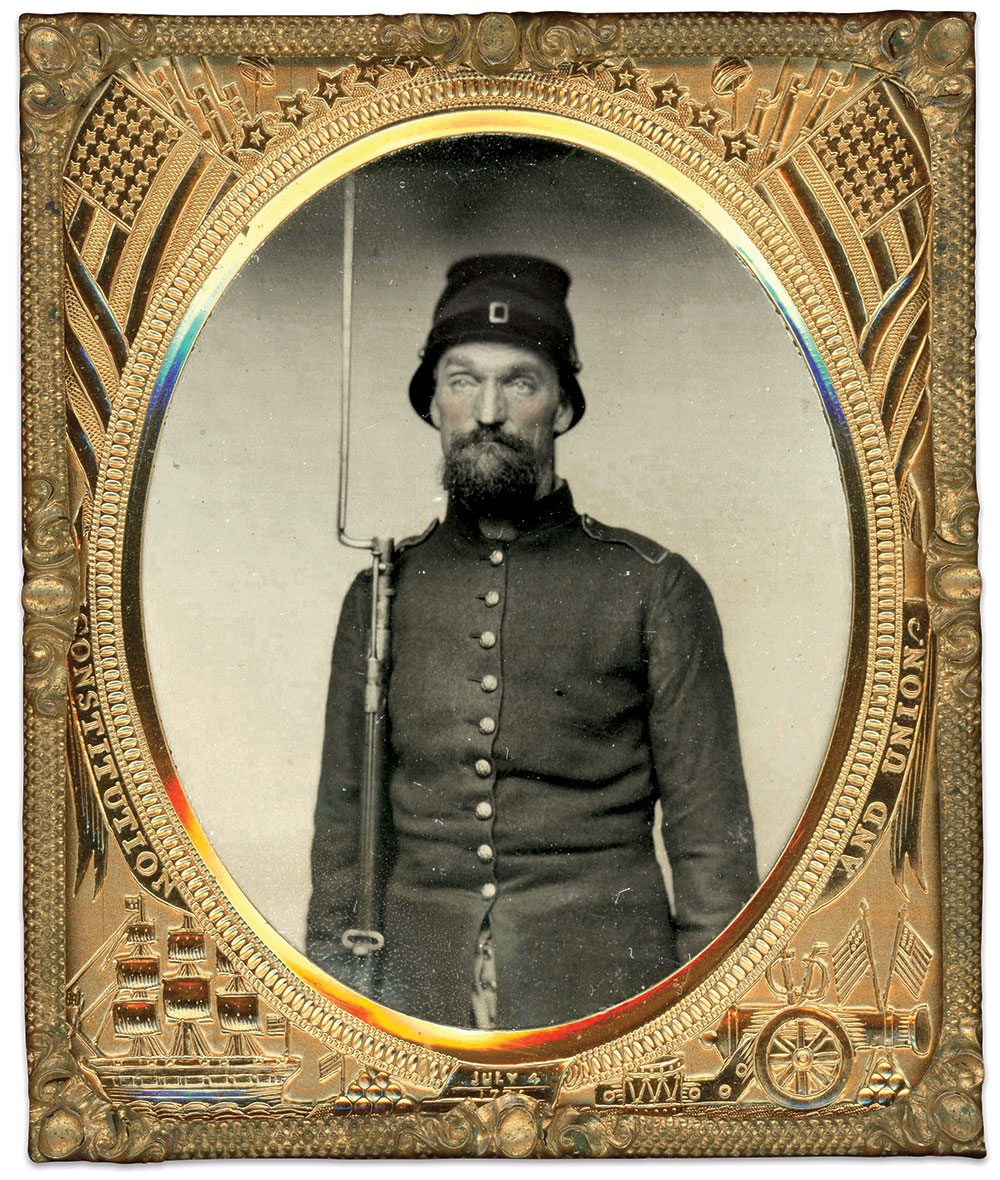
Based on photographic evidence, it appears the coats made by Benjamin Haley possessed the same pattern as those supplied by Lincoln & Shaw, with light blue-trimmed shoulder straps and devoid of any other trim. J.W. Thorpe and David F. Brown, of Hillsborough Bridge, N.H., and socks by the Holderness Woollen Mill made overcoats, shirts and drawers for this regiment.
As the war progressed, the Granite State volunteers of 1861 were re-clothed with uniforms more closely based on regulation army pattern, some of which was provided by New York and Philadelphia suppliers. In a letter to his brother published in the Independent Democrat, of Concord, on Jan. 9, 1862, a member of Company B of the 2nd New Hampshire Infantry wrote on New Year’s Day 1862, “The regiment has just been decked out in the regulation coats which is the first time we have had them. They are dark blue frock coats, and not over and above becoming, yet when the reg’t is together with equipments on, they looked very well.”
Requisitions were made during the same period for new uniforms for the 3rd New Hampshire Infantry, prompting the Dollar Weekly Mirror of Manchester to remark in its Jan. 11, 1862 edition, “The old gray suit has worn like iron, but the troops perfectly abhor the color, and have longed for a suit of blue like a child for a stick of candy.”
The newspaper reported in its January 25 edition that also received on January 9, the new issue of uniforms consisted of “forage caps, frock coats of dark blue kersey, trimmed with light blue cord, and pants also of kersey, light blue for some regiments, and dark blue for others. The pants of the New Hampshire regiments are of dark blue.” Based on images of the 3rd in camp at Port Royal, some men pinned a single company letter on their cap top.
On Feb. 11, 1862, a letter from an enlisted man of the 5th New Hampshire Infantry published in the Manchester Daily Mirror stated, “We have just received some new fatigue caps, and some scales for the shoulder. They are made of brass and made to look dressy, which indeed they do. The caps are of rather better quality than regiments in general get.” The next day a soldier in the 8th New Hampshire, known only as “Sam,” wrote, “We got all our new clothes and they are as smooth as cat fur.”
However, not all was well with these newly issued blue uniforms. On March 3, 1862, the Exeter News-Letter reported that no less than 25,000 frock coats ordered by the clothing department at Concord had been condemned as unfit and “not according to contract.” Nothing more is known, but presumably, federal government issue replaced some of this inferior clothing.
More state issue
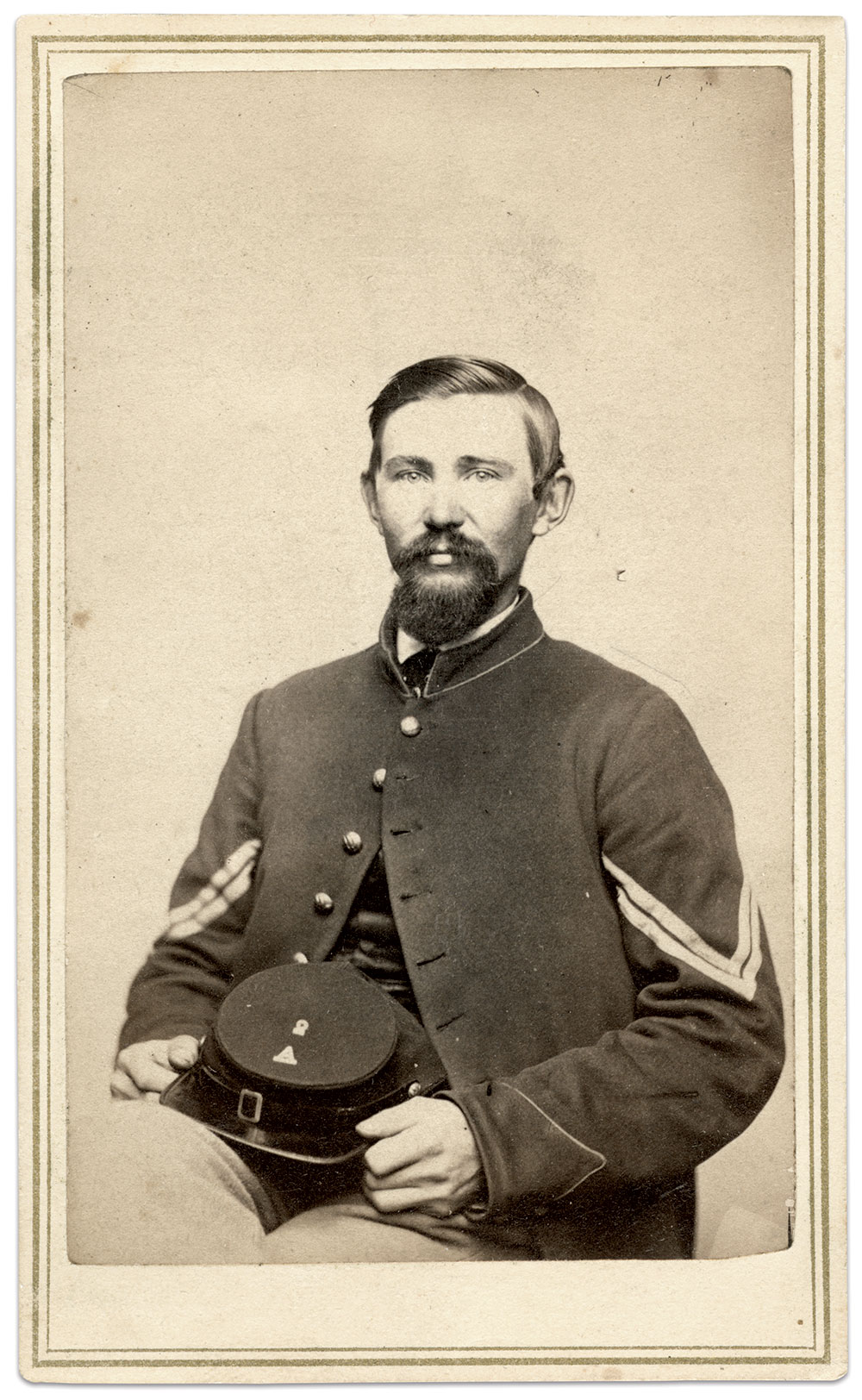
While the 1st through 8th New Hampshire infantries became known as “the old regiments,” the Granite State organized nine more infantry regiments between 1862 and 1864. At least five may have been uniformed by the state. On Aug. 18, 1862, State Adjutant General Anthony Colby advertised in the Concord press for proposals for making “Five Thousand and Fifty Three uniform Coats,” and the same number of “pairs of Trowsers.” Contracts for approximately 5,000 frock coats had been awarded within 10 days to Benjamin Haley and Abraham Thorpe, with the same amount of trousers produced by Lincoln & Shaw. In announcing this news, the Independent Democrat stated “We are glad to see these contracts given to responsible men in our State, who, we understand, do the work cheaper and better than firms in adjoining States. We have had enough of poor work done out of the State. We hold to patronizing home industry when we can save money by it, and also secure better work.” According to photographic evidence these regiments received regulation pattern uniforms although some frock coats came supplied without sky-blue infantry trim, and some sack coats with five-buttons as opposed to regulation four-buttons.
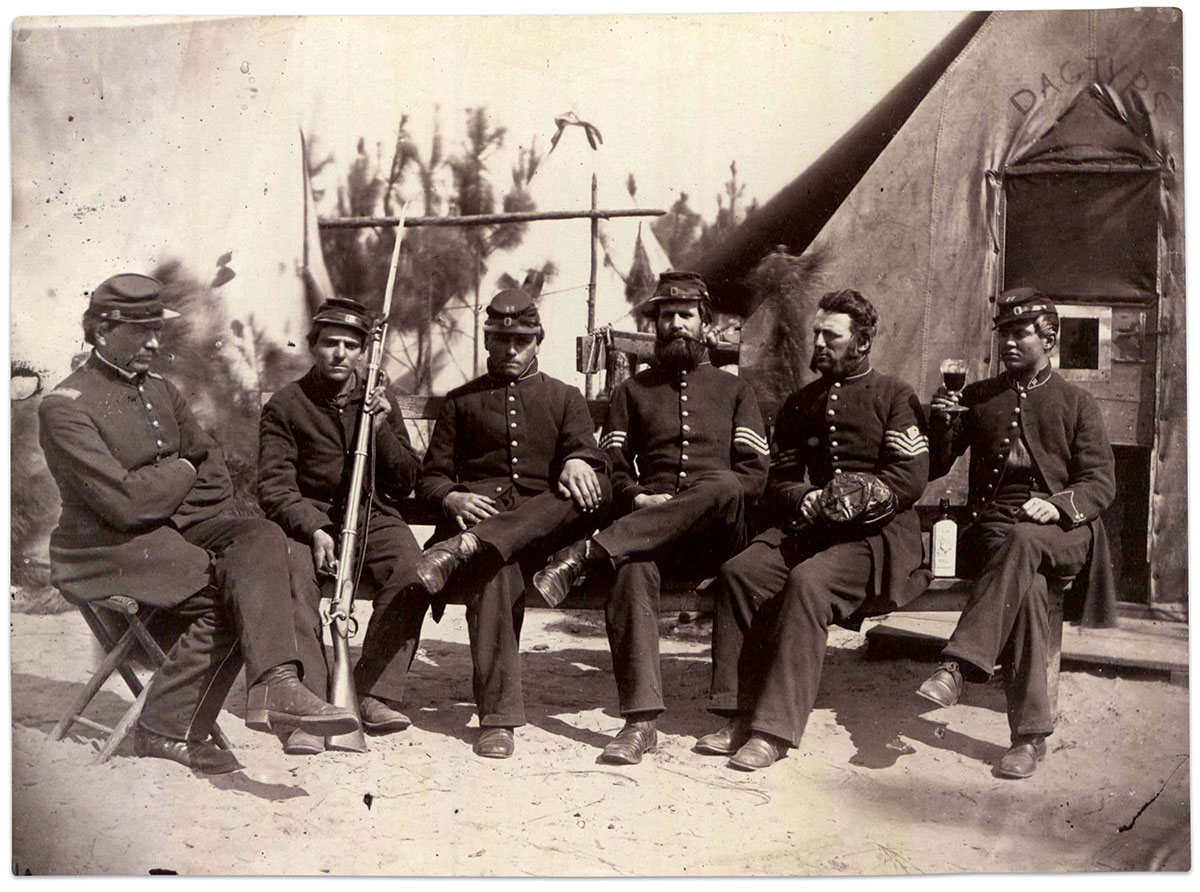
Caps of better quality
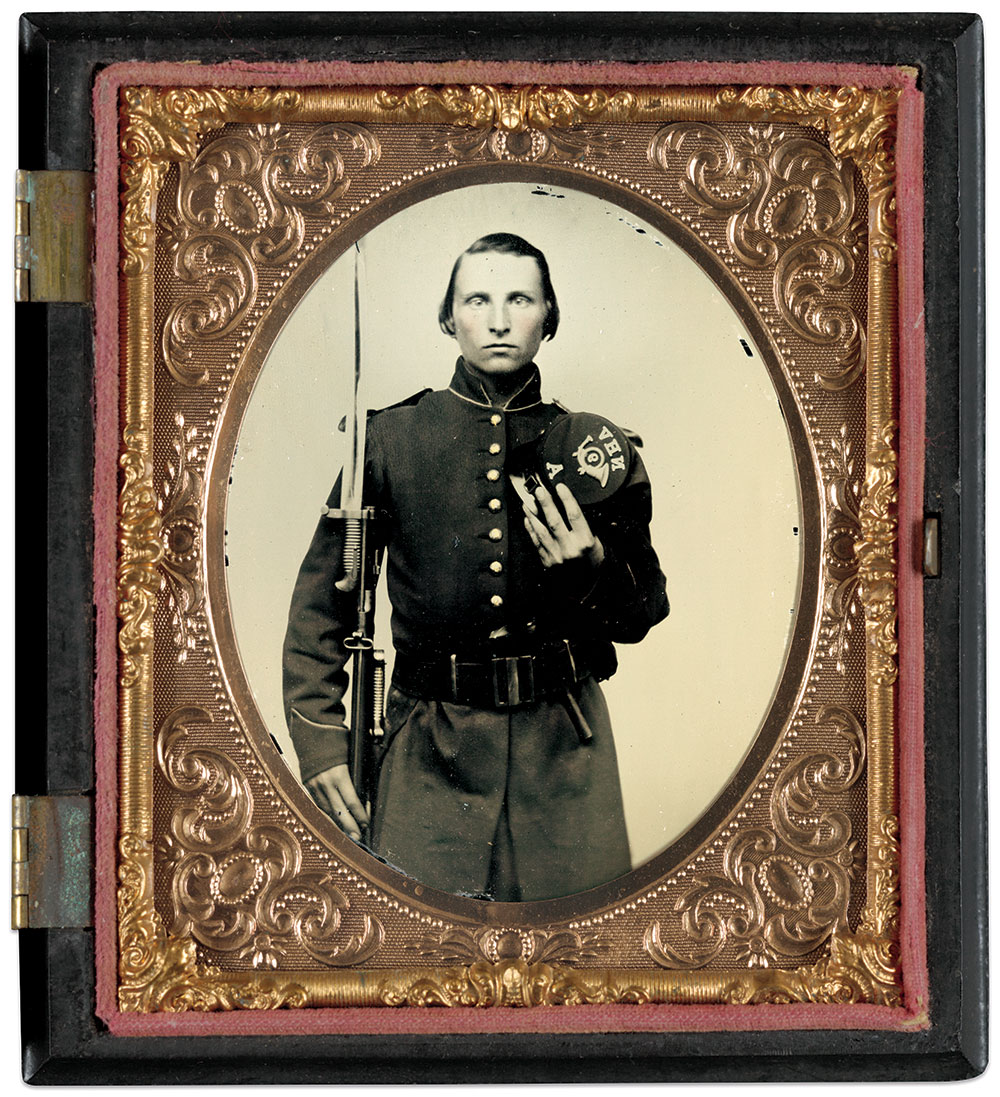
The Granite State appears to have begun issuing commercial grade forage caps during February 1862. On the 11th of that month, a letter from an enlisted man of the 5th New Hampshire Infantry published in the Manchester Daily Mirror stated, “We have just received some new fatigue caps, and some scales for the shoulder. They are made of brass and made to look dressy, which indeed they do. The caps are of rather better quality than regiments in general get.” Later in 1862, a letter from a soldier in the 5th published in the Dollar Weekly Mirror of Manchester on June 14 recounted the regiment’s performance at the Battle of Fair Oaks two weeks earlier, and related that a Confederate prisoner had asked if the “fellows with a ‘5’ on their caps” were sharpshooters.
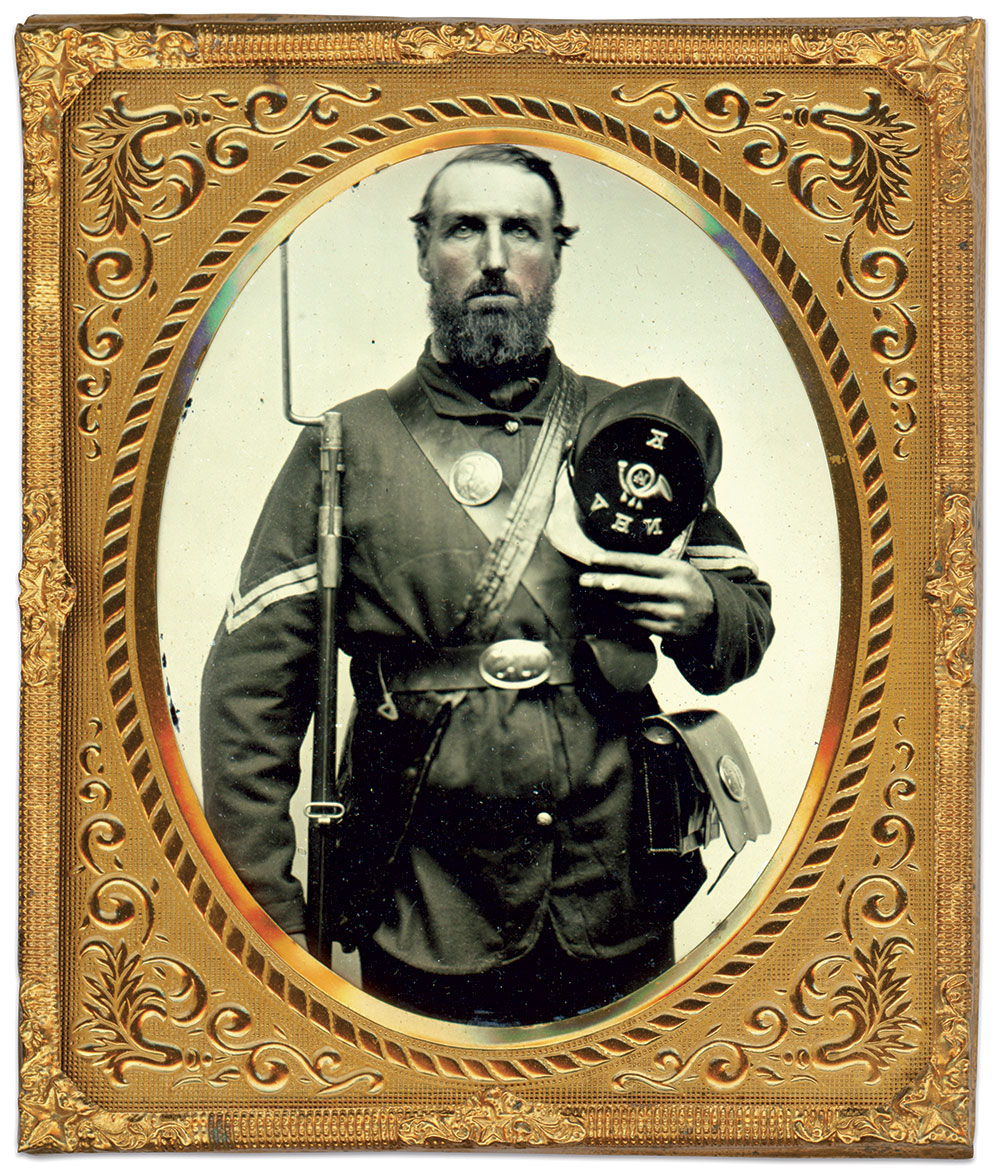
Beginning with the 9th New Hampshire Infantry, the state-issue caps were adorned with a specifically produced set of silver-plated brasses attached to the tops, and presumably issued upon enlistment of the 9th through 15th regiments during the summer and fall of 1862. These caps displayed a combination of company letter, militia pattern infantry horn with “simulated embroidery,” including cord and tassel, plus regimental number set inside the loop, and letters “NHV” (New Hampshire Volunteers). In most cases, all letters measured 5/8 inch high and numerals slightly less than a half-inch in height, as opposed to US regulations that specified 1-inch letters and three-quarters-inch numerals in brass.
Ron Field is a Senior Editor of MI.
SPREAD THE WORD: We encourage you to share this story on social media and elsewhere to educate and raise awareness. If you wish to use any image on this page for another purpose, please request permission.
LEARN MORE about Military Images, America’s only magazine dedicated to showcasing, interpreting and preserving Civil War portrait photography.
VISIT OUR STORE to subscribe, renew a subscription, and more.

